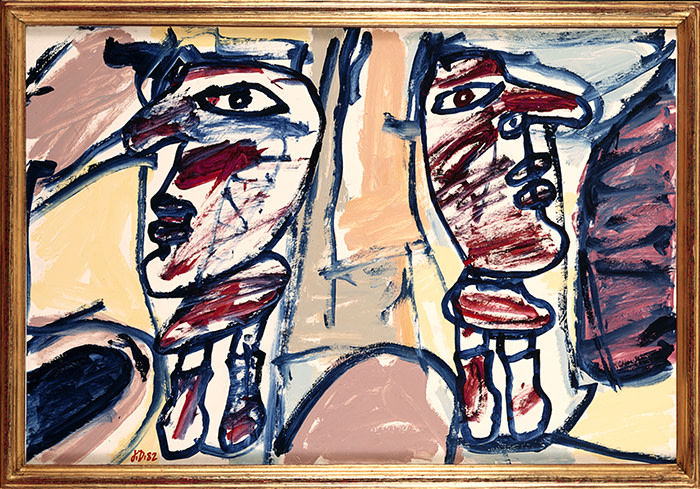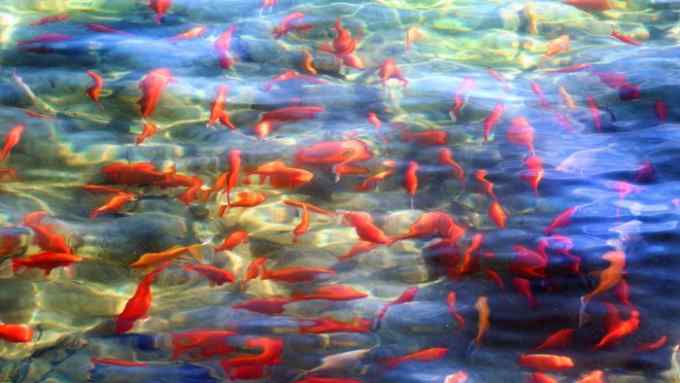Jean Dubuffet at Hauser & Wirth Zurich — madness in the metropolis

Simply sign up to the Life & Arts myFT Digest -- delivered directly to your inbox.
An inscription at the confluence of Zurich’s two rivers, the Limmat and the Sihl, asks “Yssel that the limmat?” before recommending “legging a jig or so on the sihl”. It’s a quotation from James Joyce’s Finnegans Wake, resonant for a city where art has thrived on exquisite mimicries of insanity: Dada was born here, the anarchic Cabaret Voltaire still flourishes, Joyce wrote and died here.
The contrast, minutes apart, between sober bankers on Bahnhofstrasse and tattooed hipsters leaping into the Limmat makes the place feel crazy even now, and prepares you, as you stroll along the river to the former Löwenbräu brewery on Limmatstrasse, for a superb new summer show about madness in the metropolis: Hauser & Wirth’s Jean Dubuffet and the City, imaginatively staged to resemble a mini-city itself.
Translucent white figures clamber across bright, liquefying shapes in “Rue Tournique Bourlique”. Silhouettes of buildings, suggestions of pavements, patches of walls interlock like puzzles in “Rue Poisse”. Faces spin and dip in “Vire-volte”, and multicoloured outlines of human forms disappear and reappear through an all-over reddish pink mass in “Théâtre de la rue”. Urban life as delirium and hysteria, intoxicating, alienating, seething with ghosts and objects of desire: this is a piquant presentation of the godfather of high/low graffiti art, a perfect exhibition for bourgeois/bohemian Zurich, and a wacky fringe-like enticement for Art Basel audiences an hour away.
Past crowds of squashed, squeezed figures, people inscribed into the texture of the town in the elusive opening painting “Être et paraître”, you are waved in by the jaunty “L’homme aux cocardes”, a grinning grotesque with jug ears, outsize bulbous head topped by a Napoleon bicorn hat and absurd dainty limbs: a strikingly flattened form created from graphic expressive lines and vibrant highlights in wavering, uneven paint.
Then this city’s particular imaginary architecture, transport system, networks of streets and celebrity posters unfold. Mock-flimsy, cartoonish black and white epoxy resin boulevards and buildings — “Rues et immeubles de la ville”, “Elément d’architecture contorsionniste IV” — are created from disparate cellular structures, rising even to a rippling, curved construction, “Le Cirque”, pastiche of a roundabout, emblem of mental circularity.
A gouache of a dinky green-brown number 96 bus with creamy, silvery dabs, the lovely “Autobus Gare Montparnasse (liqueur des îles)”, whose passengers are squiggly pink faces at the windows and skeletal Giacometti bodies descending from the wooden platform, looks nostalgic against the prefabricated industrial coldness of the sculptures. The disjunction is the point: Dubuffet depicts both Paris in flux in the 1940s to 1980s, when he created these works, and our twists and swerves in registering and remembering experience.
“It’s as a joke that I title [it] ‘View of Paris’,” Dubuffet wrote of the earliest work here, the 1943 wintry gouache of dark figures before anonymous tall blocks. “A more exact title,” he said, would be “View of the human mind at the moment when the thought of a View of Paris is in the process of forming itself there.”
That concern with process, the provisional, the unstable, made Dubuffet man for the moment in postwar Paris. After a career as a wine merchant he came to art late, in his forties, already with a distinctive vision and cultural project. “Instead of museums,’’ he declared, “I should like to see in the main square of every city a colossal statue of Oblivion. Let us abolish the past.” In a France recovering from Occupation and humiliation, Dubuffet’s graffiti-like scrawls, incising a scratchy black face or outline of a woman in court shoes on canvas — “Black Beauty” (1945), “Elégante aux escarpins” (1946) — announced a chance to start again, to build up from nothing.
Eventually those marks evolved into anti-memorials — the doodles in marker pen on kraft paper “Monument”, “Dessin pour un monument” — and then in the late 1970s, to vast collages of cut-out figures and abstract fragments such as “Parages fréquentés”, “Carnet de voyage”, “Argument et contexte”. Prophetic? Today, these evoke not only the busy neighbourhoods, jolting journeys, animated conversations of their titles, but our flowing, merging internet images and Instagram feeds. Yet they compel here against those very trends: as something old-fashioned, material, textural.
In “Chausée grise” and “Chausée eubaine mouillée” we feel the city through damp pavements, shrouding clouds, a blind of rain. In “Affluence” a dove-grey ground is lightened by swarms of round, ashen faces, with gazes from astonished to withdrawn; bodies meanwhile vanish into molten asphalt. Inchoate marks create yet disturb the outlines of a rudimentary figure in “Petit Hurleur”. In this extremely well-selected show — many pieces come from private Swiss collections — Dubuffet’s expressive range is a joy: these are paintings which, as the artist hoped, “let the surface speak its own language”.
To September 1, hauserwirth.com

Comments